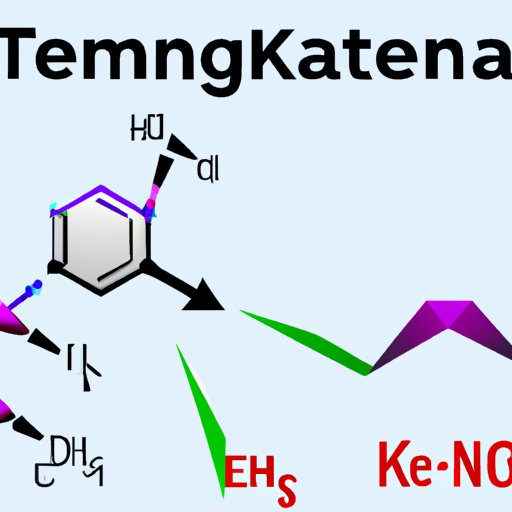Introduction
Ketamine is a powerful anesthetic with psychedelic properties that has been used for decades in medical settings. It is also a popular recreational drug, known for its euphoric effects. But what exactly is ketamine, and how does it work? In this article, we’ll explore the neuroscience and chemistry behind this psychedelic drug, and take a look at the scientific research on its benefits and risks.
Exploring the Neuroscience of Ketamine: How Does this Psychedelic Drug Work?
Ketamine is a dissociative anesthetic that produces a trance-like state. According to Dr. Matthew Johnson, a professor of psychiatry and behavioral sciences at Johns Hopkins University School of Medicine, “Ketamine works by blocking NMDA (N-methyl-D-aspartate) receptors, which are involved in regulating levels of the neurotransmitter glutamate. Blocking these receptors disrupts communication between neurons in the prefrontal cortex and other areas of the brain, which can lead to feelings of dissociation and altered perception.”
Examining Ketamine’s Mechanism of Action: What Is the Science Behind This Anesthetic?
Ketamine works primarily by binding to the NMDA receptor, a type of neurotransmitter receptor located in the central nervous system. This receptor plays an important role in neuroplasticity, which is the ability of the brain to adapt and change in response to stimuli.
In addition to binding to the NMDA receptor, ketamine also affects the neurotransmitters glutamate and gamma-aminobutyric acid (GABA). Glutamate is an excitatory neurotransmitter that increases neuronal activity, while GABA is an inhibitory neurotransmitter that decreases neuronal activity. By influencing both of these neurotransmitters, ketamine is able to alter brain activity and produce its psychedelic effects.
Investigating the Therapeutic Effects of Ketamine: How Does It Bring Relief?
Ketamine has recently gained attention for its potential therapeutic benefits. It is currently being studied as a treatment for depression, pain management, and post-traumatic stress disorder (PTSD).
Dr. John Krystal, chair of psychiatry at Yale University School of Medicine, explains that “Ketamine has a unique mechanism of action that is different from traditional antidepressants. It appears to rapidly reduce symptoms of depression, potentially within hours of administration, rather than weeks.” He goes on to explain that ketamine works by increasing the release of neurotransmitters like serotonin and dopamine, which can lead to feelings of pleasure and well-being.
Ketamine has also been studied as a potential treatment for chronic pain, as well as PTSD and other mental health conditions. These studies have found that ketamine can help to reduce symptoms of anxiety, depression, and even suicidal thoughts.
A Comprehensive Guide to the Physiological Effects of Ketamine
The effects of ketamine vary depending on the dose and route of administration. At low doses, ketamine can produce a feeling of relaxation and euphoria. At higher doses, it can cause a dissociative state characterized by vivid hallucinations, out-of-body experiences, and distorted perceptions of time and space.
The short-term effects of ketamine typically last for one to two hours. Common side effects include confusion, dizziness, nausea, vomiting, increased heart rate, and increased blood pressure. The long-term effects of ketamine use are less clear, but some studies suggest that frequent or heavy use may be associated with cognitive impairments, such as memory loss and difficulty concentrating.
The Chemistry Behind Ketamine: How Does It Influence Brain Activity?
Ketamine is metabolized by the liver and broken down into several metabolites, including norketamine and dehydronorketamine. These metabolites are then eliminated from the body via the kidneys. The half-life of ketamine is approximately two to three hours, meaning it takes about two to three hours for half of the drug to be cleared from the body.
Ketamine’s pharmacokinetics – how it is absorbed, distributed, metabolized, and eliminated from the body – also play an important role in how the drug works. For example, when administered intravenously, ketamine is absorbed quickly and reaches peak concentrations in the bloodstream within minutes. This rapid absorption allows the drug to take effect almost immediately.
Unpacking the Scientific Research on Ketamine: What Are Its Benefits and Risks?
The scientific research on ketamine is still in its early stages, and more research is needed to fully understand its benefits and risks. That said, there is evidence to suggest that ketamine has potential therapeutic benefits for certain mental health conditions, such as depression and PTSD.
At the same time, there are potential risks associated with ketamine use. These include addiction, cognitive impairment, and psychological distress. It is important to note that ketamine should only be used under medical supervision, as it can have serious side effects if taken in large doses or without proper medical oversight.
Conclusion
Ketamine is a powerful anesthetic with psychedelic properties that has been used for decades in medical settings. It works primarily by binding to the NMDA receptor, a type of neurotransmitter receptor located in the central nervous system, and by affecting the neurotransmitters glutamate and GABA. There is evidence to suggest that ketamine can be beneficial in treating certain mental health conditions, such as depression, pain management, and PTSD. However, it is important to remember that ketamine can have serious side effects if taken in large doses or without proper medical oversight.
In conclusion, ketamine is a powerful psychedelic drug with a complex mechanism of action. Understanding the science behind this drug can help us better understand its therapeutic potential and potential risks. With further research, ketamine could become an effective treatment for a variety of mental health conditions.
(Note: Is this article not meeting your expectations? Do you have knowledge or insights to share? Unlock new opportunities and expand your reach by joining our authors team. Click Registration to join us and share your expertise with our readers.)
